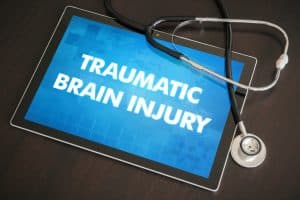Traumatic Brain Injuries in Adults and Children
 A traumatic brain injury (TBI) can change your life or the life of someone you love in an instant. TBIs can occur in just about any situation, but most often happen in accidents (motor vehicle, boating, construction, work) or as a result of contact to the head in a sporting event. TBIs can also occur as a result of an assault.
A traumatic brain injury (TBI) can change your life or the life of someone you love in an instant. TBIs can occur in just about any situation, but most often happen in accidents (motor vehicle, boating, construction, work) or as a result of contact to the head in a sporting event. TBIs can also occur as a result of an assault.
No matter how the brain injury occurs, it is important to recognize the danger signs that mean you or your loved one should go to an emergency room immediately. Delaying treatment following a TBI can result in you or your loved one having a more difficult recovery from the injury. If your loved one lost consciousness even for just a brief period, it is imperative you get them to an emergency room.
What are traumatic brain injuries (TBIs)?
According to the Brain Injury Alliance of Connecticut (BIAC), someone in the United States sustains a traumatic brain injury (TBI) every 21 seconds. A traumatic brain injury is an immediate injury that causes damage to the brain. Sometimes that damage heals, but often, it is permanent.
What causes traumatic brain injuries?
TBIs can occur when a person suffers a blow, bump, jolt, or penetration of the skull and brain. TBIs can happen from events such as motor vehicle crashes, falls, sports injuries, child abuse, or blast injuries from explosions.
What are the types of TBIs?
Traumatic brain injuries are usually categorized as mild, moderate, and severe. The symptoms and effects are often what determines the category. For example, a person who suffers from a mild TBI experiences the symptoms of a concussion, such as a brief loss of consciousness, headache, confusion, dizziness, blurred vision or eyes, and fatigue. Although the effects of a concussion can become more severe, most people recover in time.
The symptoms of a moderate or severe TBI, however, are more pronounced, and can last a lifetime. In some cases, these brain injuries can lead to a vegetative state or brain death, or may prove fatal to the victim. A person who suffers a moderate or severe TBI can experience the same symptoms of a mild TBI, as well as constant vomiting and nausea, convulsions or seizures, failing to wake up from sleep, increased agitation and restlessness, slurred speech, and a weak or numbing sensation in the arms or legs.
How do TBIs differ between adults and children?
While brain injuries affect different people in different ways, the most pronounced differences can be seen based on the age of the patient, especially in very young children who cannot articulate or communicate what is wrong with them.
For any age group, a brain injury can disrupt the victim’s ability to learn and retain new information. In young children, this can cause critical delays, essentially arresting cognitive development at the age of the victim and/or affecting the child’s treatment options later. As Brainline explains:
The effects of the TBI on the child may not be seen directly after injury, but only become apparent in the child’s life when, during the course of the child’s development, affected skills are called upon. For example, problems in abstract thinking may not be evident until the child with a TBI reaches an age when abstract thinking enters the realm of possibility for any child at that developmental level. Because of this lag in the emergence of problems, the cause of the problems (the TBI) may not be identified. Frequently, such problems are dealt with inappropriately as if they are due to learning disabilities or emotional causes. This misperception by teachers, parents, and others can devastate the child, because the strategies used to help a child with TBI are different from those used to address similar problems that stem from other causes.
One of the more pressing issues about TBI in children is the scarcity of the data. A 2017 review published in Frontiers in Neurology points out that even though TBIs are a leading cause of death in children, “the amount of pediatric-specific data in TBI is surprisingly weak. There are no robust guidelines for even basics aspects of care in children, such as [intercranial pressure] ICP and [cerebral perfusion pressure] CPP management.”
What treatments are available for TBIs?
The treatments for a TBI are dependent upon several factors, such as the size, severity, and location of the person’s injury. The main treatment for a mild TBI is rest and pain relievers for people who experience headaches.
The treatment process for people who suffer from moderate or severe TBIs, however, is a bit more complex. The main objective of medical professionals is to stabilize the patient to prevent further injury from occurring. After the patient is stabilized, there are several treatment methods that medical professionals can perform.
Treatment methods for moderate or severe TBIs in adults
Medical professionals have the ability to execute several treatment methods once a patient is stabilized. These treatment methods include surgery, medication, and rehabilitation therapies. Medical professionals can perform surgery on a TBI victim to reduce the possibility of additional damage occurring to the brain.
- Surgery. Damage such as dead brain tissue, skull fractures, and additional pressure applied to the skull are reduced courtesy of surgery.
- Medication. Medical professionals can administer anti-anxiety medication to help decrease the feelings of nervousness or fear in the patient, stimulants that help increase the patient’s alertness and attention, anticonvulsants that help decrease the possibility of seizures, and antidepressants that help treat symptoms of mood instability.
- Therapy. Medical professionals can incorporate physical therapy to help the patient regain their coordination and flexibility. Occupational therapy can help the patient relearn their daily, everyday tasks like getting dressed and bathing. Speech therapy can help the patient relearn their communication skills, and psychological counseling can help the patient to develop coping skills and improve their emotional health.
Treatment methods for moderate or severe TBIs in children
Here is where that lack of data is especially dangerous. Surgery may be an option of last resort (barring a life-threatening injury) because “children have smaller blood volumes, reduced tolerance for blood loss, increased risks of long anesthesia, different reactions to medications, and reduced tissue perfusion.” The increased risks associated with anesthesia and medications make treatment more challenging even when there is no surgical intervention.
If you or your child has sustained a brain injury in a car crash, on a job site, or in any incident caused by the negligence of others, Larson Law wants to help. Our experience brain injury attorneys in Minot, Bismarck and Fargo are only a call away. To schedule a free consultation, please fill out our contact form, or call 701-484-HURT.

Mark Larson is a Certified Civil Trial Specialist and Certified Civil Pre-Trial Specialist focusing on personal injury, car accidents, wrongful death, and oil field claims. Since 1979, Larson Law has served the injured throughout North Dakota. Read more about Mark V. Larson.
